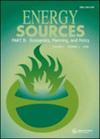A roadmap to ammonia economy: The case of Qatar
IF 2.2
4区 工程技术
Q3 ENERGY & FUELS
Energy Sources Part B-Economics Planning and Policy
Pub Date : 2023-03-08
DOI:10.1080/15567249.2023.2185839
引用次数: 0
Abstract
ABSTRACT For Qatar – a country that aims to diversify its economy, which is highly dependent on hydrocarbon revenues, and to reduce its carbon emission levels – deploying an ammonia economy would enable the country to meet these goals. This study suggests a roadmap to an ammonia economy for Qatar. A methodological approach is used to identify critical characteristics to the ammonia economy in Qatar and to insinuate strategies that can promote its development. The results show that producing gray ammonia is estimated to increase greenhouse gas emissions from 6.15 to 7.5 million tons from 2020 to 2030. However, when blue ammonia is produced instead of gray ammonia, emissions are estimated to reduce to 4.22 million tons in 2030. Moreover, The SWOT analysis is used to provide insight into the current state of the NH3 economy in Qatar and help stakeholders and decision-makers understand the challenges and opportunities that lie ahead.氨经济的路线图:卡塔尔的案例
本文章由计算机程序翻译,如有差异,请以英文原文为准。
求助全文
约1分钟内获得全文
求助全文
来源期刊

Energy Sources Part B-Economics Planning and Policy
ENERGY & FUELS-
CiteScore
6.80
自引率
12.80%
发文量
42
审稿时长
6-12 weeks
期刊介绍:
12 issues per year
Abstracted and/or indexed in: Applied Science & Technology Index; API Abstracts/Literature; Automatic Subject Index Citation; BIOSIS Previews; Cabell’s Directory of Publishing Opportunities in Economics and Finance; Chemical Abstracts; CSA Aquatic Science & Fisheries Abstracts; CSA Environmental Sciences & Pollution Management Database; CSA Pollution Abstracts; Current Contents/Engineering, Technology & Applied Sciences; Directory of Industry Data Sources; Economic Abstracts; Electrical and Electronics Abstracts; Energy Information Abstracts; Energy Research Abstracts; Engineering Index Monthly; Environmental Abstracts; Environmental Periodicals Bibliography (EPB); International Abstracts in Operations Research; Operations/Research/Management Science Abstracts; Petroleum Abstracts; Physikalische Berichte; and Science Citation Index.
Taylor & Francis make every effort to ensure the accuracy of all the information (the "Content") contained in our publications. However, Taylor & Francis, our agents, and our licensors make no representations or warranties whatsoever as to the accuracy, completeness, or suitability for any purpose of the Content. Any opinions and views expressed in this publication are the opinions and views of the authors, and are not the views of or endorsed by Taylor & Francis. The accuracy of the Content should not be relied upon and should be independently verified with primary sources of information. Taylor & Francis shall not be liable for any losses, actions, claims, proceedings, demands, costs, expenses, damages, and other liabilities whatsoever or howsoever caused arising directly or indirectly in connection with, in relation to, or arising out of the use of the Content. Terms & Conditions of access and use can be found at http://www.tandfonline.com/page/terms-and-conditions .
 求助内容:
求助内容: 应助结果提醒方式:
应助结果提醒方式:


